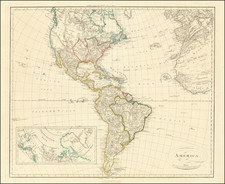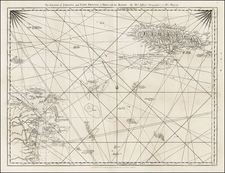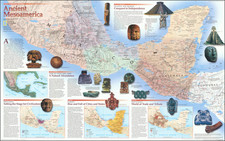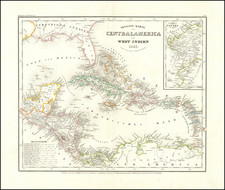Important Archive Documenting the Progress of the First Panama Canal Attempt, Prepared for Investors
Fine set of maps, profiles, and forms from the Compagnie Universelle du Canal Interocéanique, which spearheaded the first attempt to dig a canal across Panama in the 1880s. The archive contains six maps, including two that are over ten feet long, a booklet detailing the history of the company's efforts, prepared for prospective investors, and several other documents. The archive is contained within a company portfolio.
This archive, amassed over the course of the history of the Compagnie, would have been presented to investors over a period that represents the decline and fall of the French efforts to build the canal. Groundbreaking on the canal was in December of 1879, but by the first half of the 1880s investors and workers were already demoralized. These maps were produced to show the continued progress of the canal, detailing all the work that had already been done. Despite the repeated efforts to draw in more investment, the Compagnie would fold in 1889.
One of the reasons that the Compagnie was unsuccessful was their goal of building a sea-level canal--that is, one that does not use locks. The terrain of the isthmus is not conducive to this plan, and several of the plans detail the issues of a sea-level canal, showing the geology and topography which would need to be cut. These plans reveal that the Compagnie was aware of the issues that would contribute to their demise.
Despite the demise of the Compagnie Universelle, there was still worldwide demand for a canal, and a significant amount of labor had already been expended in making cuts for the canal. As such, the Compagnie Nouvelle was formed to try and recoup some of the lost investment by selling the work to a third party. The final documents which appear in the presented archive relate to this period in the canal's history, when foreign investment was courted. A document prepared for the Paris Universal Fair of 1900 describes the progress of the canal to would-be buyers. Eventually, the US government would finally acquire the company in 1904 for the cost of $30,000,000.
This archive tells the story of the first attempt at the Canal, from initial optimism to the realization of problems, and finally to the point where the US would step in to finish the task.
Contents
- Situation de L'Isthme de Panama Echelle = 1/100,000.
- A wonderfully detailed manuscript map and infographic. The top portion is a map of the railroad and the proposed canal route, complete with stations and major geographic features. The middle portion shows the canal route in profile, with divisions by the contractor working on each portion of canal, the various construction sites, and the names of the intervening mountains, rivers, and landmarks. The bottom third shows cross-sections of the canal as it appears in the sea approach, surrounded by land, and by rocks. A special point of interest in this document is the color-coded geologic information, with a key at the bottom. The geology of the area was of particular importance for a sea-level canal, as this involved significant excavation of debris, rock, and soil. This geologic detail is not included in the printed version of this map and profile.
- Compagnie Universelle de Canal Interocéanique de Panama Tracé du Canal et Situacion des Travaux en Cours d’Éxécution au 1er. Juin 1883.
- The upper half shows a map of the canal and the Panama Railroad, while the lower half includes the detailed profile of the canal route. The first item listed above appears to be the source for this printed work.
- Plan General Indiquant Le Trace Du Canal Les Deviations due PRR et les Derivations Echelle 1/50000.
- This map includes extensive manuscript annotations, in red and black, which divide the canal route into separate divisions. On the actual route itself, individual work parcels and contractors are indicated, offering insight into the progress and projections of the Compagnie.
- Plan General Indiquant Le Trace Du Canal Les Deviations due PRR et les Derivations Echelle 1/50000.
- A second, unmarked example of the item above.
- Untitled profile
- Massive view that highlights the geographic challenges faced by a sea-level canal plan. The profile is an impressive 160 inches long.
- Plan Topographique de la Région du Canal Dressé d’après les Etudes faites par la Compagnie du Canal Interocéanique Echelle 1/20000.
- This huge, 190-inch-long printed map shows the route of the canal plan (dashed-and-dotted line) and the Panama Railroad, which the canal closely followed. It includes profile views that compare sea-level with the terrain the canal would pass through. A reduced version of this seems to have been included in an atlas by de Lesseps, but otherwise is unremarked upon in the literature we could access.
- Other items: Blank form for updates of works, title page for the Plan General to report updates, and two documents about the successors of the Compagnie Universelle, the Compagnie Nouvelle.
Early schemes to cross the Isthmus of Panama
The idea of connecting Pacific and Atlantic, the world’s two largest oceans, has long appealed to government officials and traders. The Isthmus of Panama, a tiny thread of land separating the seas, has always seemed the geographically perfect location for such a connection. The highly-strategic locale drew interest for centuries, from seventeenth-century English privateers to the doomed Scottish colony in Darien to Alexander Humboldt’s plans for a canal.
In the nineteenth century, proposals proliferated, but the actual journey over the isthmus involved a canoe and mule journey through the jungle. Thanks to the development of railway technology, planners thought a cross-isthmus railroad more feasible than a canal. William Aspinwall and partners proposed the Panama Railroad in 1847, arguing that it would be useful for military and commercial transport. A year later, the need for such a railroad became more urgent as thousands streamed to California in search of gold.
The Panama Railroad was completed in 1855 at Summit, ten miles northwest of Panama City. This terminus would later be renamed Culebra. The line was 47.5 miles long. Travelers could disembark their ships at Aspinwall, on the Atlantic side, which became Colón, and then walk to their train. To pass the treacherous Chagres River, trains passed via Barbacoas halfway through the journey. However, the wild river could still threaten the railroad, as it did in 1887, when a 46-foot rise in a flood put the bridge underwater.
The French plan
While the Panama Railroad was chugging across the jungle, the Suez Canal was finished in the Egyptian desert in November 1869. The project had been championed by Ferdinand de Lesseps, the former French consul to Cairo. In the late 1870s, de Lesseps turned his attention to Panama.
Lieutenant Lucien N. B. Wyse had explored the area while on assignment from the Société Civile Internationale du Canal Interocéanique de Darien in 1876. At that time, he submitted a plan for a canal with locks, but the head of the Société Civile, de Lesseps, rejected the idea. Wyse did a second survey in 1877. He also traveled to Bogotá to negotiate with the Colombian government, of which Panama was then a part. Wyse convinced the Colombian government to grant the Société Civile a 99-year lease and exclusive rights to build a canal; the deal became known as the Wyse Concession.
In 1879, de Lesseps oversaw the International Congress for the Study of an Interoceanic Canal (Congrès international d’ètudes du canal interocéanique), where engineers and enthusiasts submitted proposals. The winning plan came from Lucien Wyse and Armand Rèclus. They suggested a sea-level canal that followed the rail line already in use; Wyse knew from prior experience that de Lesseps had no interest in a canal with locks.
In the same year, 1879, de Lesseps was named president of the Compagnie Universelle du Canal Interocéanique. The idea of a canal was wildly popular in France; the company’s stock was oversubscribed in three days. In December, de Lesseps journeyed to Panama to turn over the first shovel of dirt—the canal was underway.
Over the course of eight and a half years, Compagnie workers, many of them West Indians, excavated more than 75,000,000 cubic yards of material. However, they faced earthquakes, flooding, landslides, heat, and, worst of all, mosquitos bearing yellow fever and malaria. The terrain was difficult, deep swamps gave way to high mountains, which made a sea-level canal all but impossible to control and complete.
By 1885, the workers were demoralized and the investors fatigued. De Lesseps returned to Panama in 1886 to rescue the project and boost confidence in the venture. It was not enough. The Compagnie folded in 1889, devastating its investors. The workers paid a higher price: 20,000 died while the French attempted their canal.
Despite their failure, the French still appreciated the need for and interest in a canal. The Compagnie Universelle was repurposed as the Nouvelle Compagnie Universelle. They offered their exclusive rights and equipment to the United States for $109,000,000. The USA passed, however, preferring to back a project across Nicaragua. A volcanic eruption halted that plan and the Senate approved the purchase of the Nouvelle Compagnie for $40,000,000 on June 19, 1902.
The former General Director of the French attempt, Philippe Bunau-Varilla, had stayed in Panama. When the revolutionaries of Panama, supported by the United States, rebelled against Colombia, Bunau-Varilla was named Plenipotentiary-Minister. He then drew up a new canal treaty with the United States. This one gave the USA favorable access and terms, at the expense of the Panamanians.
The Americans began to build their canal in 1904. They led an extermination campaign against mosquitoes to improve worker health and repurposed the aging Panama Railroad. The engineers decided to abandon the sea-level canal in favor of locks that would carry ships to man-made lakes in the center of the country. The canal opened to interoceanic traffic on August 15, 1914, when the S.S. Ancon passed through the locks.
Rarity
Such a cache of documents, which includes both manuscript and printed maps, is rare. Most of the Compagnie’s papers are institutionally held, primarily by the Bibliotheque Nationale in Paris.
Of the maps in the presented archive, the following rarities apply:
- We were unable to find any additional examples, through OCLC or other search engines, of the Situation de L'Isthme de Panama.
- One example of the 1883 Compagnie Universelle map was traced, in the BNF.
- One example of the Plan General 1/50000 is located, in the Library of Congress.
- The Plan Topographique was reproduced in a reduced version, but we were unable to find an additional example of the full-scale version












![[Hand Drawn Map] Le Golfe de Mexique avec les Pays Circonvoisins](https://storage.googleapis.com/raremaps/img/small/91580.jpg)



![[Galapagos] Carte de la Cote Occidentale D'Amerique Comprise Entre Le Golfe de Tehuantepec et le Golfe de Guayaquil (Amerique Centrale, Nlle Grenade, Equateru) . . . .1864](https://storage.googleapis.com/raremaps/img/small/57942.jpg)